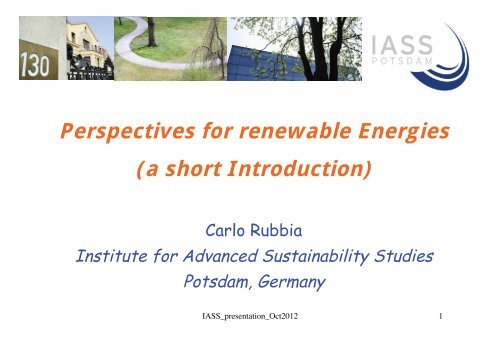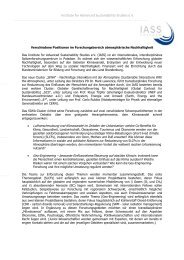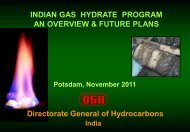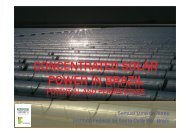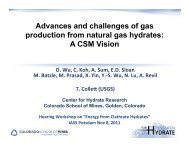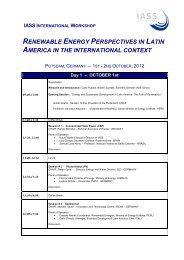You also want an ePaper? Increase the reach of your titles
YUMPU automatically turns print PDFs into web optimized ePapers that Google loves.
Perspectives for renewable Energies(a short Introduction)<strong>Carlo</strong> <strong>Rubbia</strong>Institute for Advanced Sustainability Studies<strong>Potsdam</strong>, Germany<strong>IASS</strong>_presentation_Oct20121
The Earthʼs climate: an extremely fragile system Global earth’s temperature over the last 420’000 yearsbased on the Vostok ice core from the Antartica.Probable beginningof Homo sapiensEarliest skulls ofHomo sap. in AfricaAgriculturebegins Our modern life could have been impossible outside thesevery short inter glacial periods.<strong>IASS</strong>_presentation_Oct2012Slide# : 2
Temperatures and CO 2 concentrations of the last 10ʼ000 y Temperatures of thelast warm periodfollowing the lastglaciation (≈11’000 y) There has been analternance of warmerand cooler periods ata millenary scale. CO 2 concentrationsare shown in thelower curve. Correlations betweenCO 2 and temperaturetiny and not evident Today the CO 2concentration is 380ppmv from 280 ppmvat the end of period.<strong>IASS</strong>_presentation_Oct2012Warmer periodsTemperature at the summit of Greenland IceCO2 atmospheric concentrationSlide# : 3
Stability of the climate: a necessary premise for human life The permanence of the warm period after the last interglacialperiod has been essential to create and to sustain lifeand civilization as they are today, an essential element forsurvival that we must preserve at all cost. As well known, we are presently facing a new phenomenon:the emergence of a man made Antropogenic Era, in which forthe first time human activities strongly influence the futureof the earth’s climate. For instance, since 1750, about one million of millions tons,1000 Gtons, of CO 2 have been injected into the air, to whichmany other pollutants have to be added. The first signs of an Antropogenic Era have been alreadydetected. These effects must be urgently curbed to avoidthe irreversible effects of a major climatic change.<strong>IASS</strong>_presentation_Oct2012Slide# : 4
Man made fossil CO 2 emissions are rising at a rapid paceIPCC A1B predictionsof a fully uncurbedemission process?6 GtC/ybu 2020 ? From about 6 GtC/y in 1995, we are now at 9.5 GtC/y. By2020 and at the present rate CO2 will reach ≈ 12 GtC/y.<strong>IASS</strong>_presentation_Oct2012Slide# : 5
How long will CO 2 last in the biosphere ? The mean atmospheric CO 2lifetime of order 10 4 years isin stark contrast with the“popular” perception of onlyseveral hundred years. The mean lifetime of fossilCO 2 is about 30–35 kyr As a comparison, the lifetimeof Pu-239 is 26 kyr,associated with the todayspublic perception of nuclearenergy. This simplification misses thelongevity the CO 2 lifetime.ppmv CO 2 EmissionsCaldeira, K., and M. E. Wickett (2005), J. Geophys. Res., 110, C09S04.Archer, D. (2005), J. Geophys. Res., 110, C09S05<strong>IASS</strong>_presentation_Oct2012600 yearsSlide# : 6
Many different, contrasting effects….Gases Increase theGreenhouse EffectAerosols Keep theEarth Cool!Aerosol particles do cool the Earth and they are presentlyoffsetting the greenhouse effect warming.This is a provisional balance, in view of the long lifetime of CO 2<strong>IASS</strong>_presentation_Oct2012Slide# : 7
An unstable balance: CO2 warming and aerosol cooling The 3 Wm −2 GHGs change should have led to a warming of 2.4 °C.BUT the observed warming trend is only about 0.75 °C, or only ≈30% of what naively expected anthropogenic warming until 2012. Why ?<strong>IASS</strong>_presentation_Oct20120.75 Wm -2 -20% (-0.5 °C warming) still stored in the oceans aerosol masking effects (-2.1 + 0.9) = −1.2 Wm −2 cooling by land changes -0.2 Wm −22.65 Wm -2 Antropogenicwarmupon course !2.65 Wm −2to0.75 Wm −2Slide# : 8
Between political promises and actual realities The unsuccessful Kyoto Protocol’s commitment period comes toan end in 2012. This is a dilemma, since man-made GHGs thatsurrounds the planet have trapped already 3 Wm −2 (2.6–3.5). All major emitters of greenhouse gases (GHGs) have agreed in2009 under the CHA (Copenhagen Accord, not Agreement) thatglobal average temperature increase should be kept below 2 °C,implying that the overall radiant energy change should ≤ 2.5(1.7–4) Wm −2 and, to this effect, to “take action to meet thisobjective consistent with science and on the basis of equity”. But as such, the CHA is just a political document, and during thelast decade no dramatic warming effect has actually appeared. Will the decisions of a major reversal of GHG emissions (-20%respect to 1995 values by 2020 or even more) be actuallyimplemented, with the corresponding financial investmentswhich of course should be starting now to be ready by then ? An implicit tendency to continue with “fossil burning as usual” !<strong>IASS</strong>_presentation_Oct2012Slide# : 9
And in the meantime :Artic Sea Ice snow cover !19792007<strong>IASS</strong>_presentation_Oct2012Slide# : 10
Curbing the effects of fossils with CO2 sequestration ? Much discussion has been going on on the possibility of asubstantial CO 2 sequestration underground or under the seas.In our view this alternative is unrealistic, since: Its very long lifetime: we need CO 2 wells safely underpressure for >10 3 years: sequestration is not elimination Only a limited fraction of the collected CO 2 offers thenecessary premises to ensure potential recovery. But inorder to maintain 550 ppm by 2100 with the option “Businessas usual” –according to IPCC– ≈ 2x10 12 ton must be stored. The degradation processes from leaks of wells and behaviourover long times are difficult to predict. Although not toxic,above some %, CO 2 losses in the atmosphere will act as apowerful and toxic brain vein dilatator. Unconsciousness willoccur at promptly at 15 % and immediate death at 30%concentrations.<strong>IASS</strong>_presentation_Oct2012Slide# : 11
Genetic Engineering: an impossible mission ?In response to New York Times Op-EdHow to Cool the Globeby Ken Caldeira, October 24, 2007<strong>IASS</strong>_presentation_Oct2012Slide# : 12
Aerosol SO 2 cooling If there were a way to continuously inject SO 2 into the lowerstratosphere at a level of ≈ 1/1000 of the CO 2 emissions, itwould produce a very large, compensatory global cooling. Tropical SO 2 injection would produce sustained cooling overmost of the world, with more cooling over continents. Windswill spread them around and produce global cooling, liketropical volcanic eruptions have. Arctic SO 2 injection would not just cool the Arctic, wherethey will keep sea ice from melting, while any negative effectswould not affect many people. Solar radiation reduction produces larger precipitationresponse than temperature, as compared to greenhouse gases. BUT both tropical and Arctic SO 2 injection might disrupt theAsian and African summer monsoons, reducing precipitation tothe food supply for billions of people.<strong>IASS</strong>_presentation_Oct2012Slide# : 13
Temp Anomaly (°C) from 1951-1980 mean1.41.31.21.11.00.90.80.70.60.50.40.30.20.10.0-0.1-0.2-0.3-0.4-0.5SO2 injections in the stratosphereGISS Global Average TemperatureAnomaly+ Anthro Forcing, 3 Mt/yr Arctic,5 Mt/yr Tropical, 10 Mt/yr TropicalGeoengineeringendsGeoengineeringstartsAt the end of SO 2injection period,CO 2 causedRobock, Alan, Allison B. Marquardt, Ben Kravitz,effects willand Georgiy Stenchikov, 2009: The benefits,promptlyrisks, and costs of stratospheric geoengineering.Geophys. Res. Lett., 36, L19703, doi:return1880 1890 1900 1910 1920 1930 1940 1950 1960 1970 1980 1990 2000 2010 2020 2030 2040<strong>IASS</strong>_presentation_Oct2012Slide# : 14
Aereosol tropical injection after 10 y NH winterand 5 Mt/yafter 10 yNH summerand 5 Mt/yafter 10 y<strong>IASS</strong>_presentation_Oct2012Without aerosol coolingWith aerosol coolingSlide# : 15
Future and more realistic perspectives The current worldwide energy supply is based mainly on theavailability of fossil fuels and though there is much talk ofthe exhaustibility of these resources, they will remainindispensable in the decades to come. Therefore and in order to curb environmental changes anurgent necessity is to proceed simultaneously on two parallellines: a more efficient and friendly utilization of fossils fuels,curbing the effects of their antropogenic emissions; the development and progressive utilization of therenewable energy sources. The transformation of existing energy technologies into lowemissionand innovative solutions with a quantitativelysignificant management of CO 2 , is one of the most importantscientific and technological challenges of our times.<strong>IASS</strong>_presentation_Oct2012Slide# : 16
A novel idea: combustion of methane without CO 2 emissions Methane cracking or Methane decarburation is a scientificallyproven process based on the splitting of the Methane moleculeinto is atomic components (Carbon and Hydrogen). As an alternative without CO 2 emissions, we are investigating at<strong>IASS</strong>/KIT the scientific and technical aspects of a different, imethod: spontaneous, thermal dissociation of NG : CH 4 -> 2H 2 +C Hydrogen becomes the final form of energy. The released solid carbon, in the form of carbon black, can beremoved mechanically and eventually used by industry in themanufacture of tyres, batteries, and even as a fuel. The practical implementation of a CO 2 -free technology for theproduction of Hydrogen from methane or from any other sourcewill have a significant impact in many sectors. Substantially neglected sofar, it would allow to use the huge andvast amounts of NG without any CO 2 emissions !<strong>IASS</strong>_presentation_Oct2012Slide# : 17
A better way: Renewable energies for the future ? Solar and wind energy will achieve the most success in thenext tenure. For the new installations, wind costs alreadyonly 6 ¢/ kW-hour.A new paradigm ! In the North Sea there is the opportunity of building offshoreturbines on a 60,000 km 2 area, which can provideelectric energy for the entire EU. In the sun belt, theelectric energy produced by a CSP of the size of Lake Nasserequals the total Middle East oil production. Without any doubt capacities of such new energy sources willonly grow very quickly. By 2017, wind will grow larger thannuclear energy. Today technologies develop fast. In 1990, we had 100 kW, in2010 a wind turbine will have the capacity of 10 MW.Therefore, wind and solar may substitute coal, oil and gas, asa result of a number of advantages.<strong>IASS</strong>_presentation_Oct2012Slide# : 18
BiomassGeothermalWindHydropowerTypical Yield≈1 GWh el /km²/y ≈1 GWh el /km²/y ≈ 30 GWh el /km²/y ≈ 30 GWh el /km²/y890 TWh el /y750 TWh el /y1700 TWh el /y 1090 TWh el /yEconomic potentialsDemand of electric power:Typical yield CSP, PV≈250 GWh el /km²/y» 7 500 TWh/y Europe + Desert 2050» 35 000 TWh/y world-wide 2050Economic potentials > 600 000 TWh el /y<strong>IASS</strong>_presentation_Oct2012Gerhard Knies, ISES-Rome CSP WS 2007Slide# : 19
Wind variability must be overcome with storage Wind variability in Germany. Percentage of electrical demanddelivered by all the wind turbines of E.ON Energie during theyear 2006. Averaged over the year, wind power delivered18% of installed capacity. (Courtesy of E.ON Energie)<strong>IASS</strong>_presentation_Oct2012Slide# : 20
Geothermal energy: an untapped resource Commercial electricity generationfrom geothermal steam began atLarderello (Tuscany) a long timeago (1913), At the end of 2006,the capacity in Italy was 810.5MWe 25% of the electricity ofTuscany, i.e. 2.5 million households At the end of 2007, the installedgeothermal capacity in the worldexceeded 9,730 MWe.<strong>IASS</strong>_presentation_Oct2012Slide# : 21
Solar energy in the “sunbelt”(210 x 210 km² = 0.13% of deserts)is receiving yearly averaged solar energy equal toglobal energy consumption (15 TW x year)Where is the energy problem ?Gerhard Knies, ISES-Rome CSP WS 2007<strong>IASS</strong>_presentation_Oct2012Slide# : 22
Principle of modern CSP<strong>IASS</strong>_presentation_Oct2012Slide# : 23
Fresnel lens vs parabolic through ?<strong>IASS</strong>_presentation_Oct2012Slide# : 24
The great substitutionStandard, fossildriven applicationSolar driven applicationwith energy storage<strong>IASS</strong>_presentation_Oct2012Slide# : 25
The thermal storage of energy from a CSP Indeed any primary main form of energy, in order to be realistically capableto counteract fossils and their emissions must be available whenever it isneeded by the user and not according to the variability of the source. It is possible to insure the continuity of utilisation of CSP plant with theaddition of a thermal liquid storage, in the form of a cheap molten salt.No press.No FlameFlammablePressureComparing to Hydro: Thermal storage efficiency per unit mass is equivalent toa gravitational water drop height of 72.68 km!<strong>IASS</strong>_presentation_Oct2012Slide# : 26
Key problems for renewable energies The best energy is always the cheapest energy: the cost ofrenewables must be strongly reduced in order to ensure itscost competitivity with fossils and nuclear. Energy must be available when it is needed: the variability ofsolar, wind must be curbed with the help of an effectiveenergy storage. Renewable energies are mostly generating electricity, whencompared with fossils which produce thermal heat. Renewable energies require much wider surfaces of collectionlocated in specific locations in which production is optimal. Electricity and very high powers (GWatt) must betransported and over much longer distances than today,comparables to the ones possible today for NG and oil.<strong>IASS</strong>_presentation_Oct2012Slide# : 27
Environmental Impacts: Area requirementsAverage land surface (km 2 ) for1 MW x year of electric energy[integrated over the full year24 x 365= 8760 hours]Source: J. Davidson 2006 <strong>IASS</strong>_presentation_Oct2012Slide# : 28
Long-distance energy transport Remote renewable energy sources require an efficienttransfer of electrical energy over long distances. High power lines may have lengths of more than 4000 km<strong>IASS</strong>_presentation_Oct2012Slide# : 29
The EU-MENA Solar project in EuropeBy 2050Area: 2500 km 2Capacity: 100 GWattTransfer:700TWh/yEU needs:7500TWh/yCosts:Turnover: 35 G€/ySolar 350 G€HV lines: 50 G€Electricityby 2050The planned EURO-MED electricity interconnection permits to produce from theSahara large amounts of wind/solar electricity toward the Pan- European network.<strong>IASS</strong>_presentation_Oct2012China_CSP_Sept2011Nasser Lake area= Oil + Gas fromSaudi ArabiaSlide# : 30
Renewable energies in ChinaWindSolarHydroChina_CSP_Sept2011<strong>IASS</strong>_presentation_Oct2012Electric demandsLiye Xiao, Institute of Electrical Engineering, CASSlide# : 31
Superconductivity in the transport of electricity Renewables and liberalisation require bulk transmission capacity to ensureelectricity transport over many thousand kms from off-shore wind andCSP Electricity transport over ≈3000 km: AC / HVAC lines: high cost and 45% / 25% energy losses 800 kV HVDC lines: lower costs and 10% energy losses Superconducting (SC) power lines: new promising line for developmentNominal power: 10 GWatt at ≈100 kVoltSmall superconductingcryogenic pipelineTube diameter ≈ 50 cm<strong>IASS</strong>_presentation_Oct2012With 800 kV HVDC, the overhead surface for the EU-MENA-2050 lines is 3600 km 2 , to be compared with 2500km 2 for the CSP plant itself: SC lines are almost a necessity.Slide# : 32
The new choice in long power lines:MgB 2 In January 2001 superconductivity was announced of a simplenew compound, the Magnesium Diboride, MgB 2 . MgB 2 is under development and relatively small quantities ofcable have been manufactured so far at the laboratory scale.Chemical phase Metallurgical phaseManufacturingof MgB 2 wiresTube filling An extremely simple method of producing the cheapchemicals and of drawing the wire, in analogy with Nb-Ti. Wire unit length today up to 20 Km in a single piece, easilyscalable by increasing billet size/length. Conductor cost at 20K, 1T:now 1.5 €/kAm; in 3 y 0.5 €/kAm<strong>IASS</strong>_presentation_Oct2012by simple ex-situPowder-In-Tubemethod Slide# : 33wire drawingto 2 mmcold rolling
Concluding remarks A coherent energy policy is required, strategic choices have tobe made, relaying on truly innovative scientific and technologicaldevelopments, in order to reconcile sustainable development andeconomic growth with the threat of environmental decay. Our society will depend crucially on uninterrupted anddifferentiated energy supply. Therefore major steps have to betaken in order to avoid potential geo-political and pricevulnerability. We should play a very important role in order to foster theabsolutely necessary fundamental breakthroughs and catalyzeinnovation in a coherent international framework. Only through such a concentrated and coordinated effort,leadership can be targeted and the objectives of creating highquality employment opportunities and a better quality of life bemet.<strong>IASS</strong>_presentation_Oct2012Slide# : 34
<strong>IASS</strong>_presentation_Oct2012Slide# : 35
Thank you !<strong>IASS</strong>_presentation_Oct2012Slide# : 36


